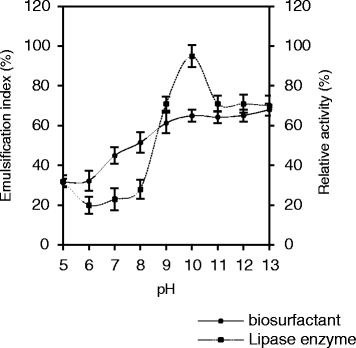Lipase and biosurfactant from Ochrobactrum intermedium strain MZV101 isolated by washing powder for detergent application
- PMID: 28923075
- PMCID: PMC5604193
- DOI: 10.1186/s12944-017-0565-8
Lipase and biosurfactant from Ochrobactrum intermedium strain MZV101 isolated by washing powder for detergent application
Abstract
Background: Alkaline thermostable lipase and biosurfactant producing bacteria are very interested at detergent applications, not only because of their eco-friendly characterize, but alsoproduction lipase and biosurfactant by using cheap materials. Ochrobactrum intermedium strain MZV101 was isolated as washing powder resistant, alkaline thermostable lipase and biosurfactant producing bacterium in order to use at detergent applications.
Methods: O. intermedium strain MZV101 produces was lipase and biosurfactant in the same media with pH 10 and temperature of 60 °C. Washing test and some detergent compatibility character of lipase enzyme and biosurfactant were assayed. The antimicrobial activity evaluated against various bacteria and fungi.
Results: Lipase and biosurfactant produced by O. intermedium strain MZV101 exhibited high stability at pH 10-13 and temperature of 70-90 °C, biosurfactant exhibits good stability at pH 9-13 and thermostability in all range. Both lipase and biosurfactant were found to be stable in the presence of different metal ions, detergents and organic solvents. The lipase enzyme extracted using isopropanol with yield of 69.2% and biosurfactant with ethanol emulsification index value of 70.99% and yield of 9.32 (g/l). The single band protein after through from G-50 Sephadex column on SDS-PAGE was calculated to be 99.42 kDa. Biosurfactant O. intermedium strain MZV101 exhibited good antimicrobial activity against Gram-negative bacteria and against various bacterial pathogens. Based upon washing test biosurfactant and lipase O. intermedium strain MZV101considered being strong oil removal.
Conclusion: The results of this study indicate that isolated lipase and biosurfactant with strong oil removal, antimicrobial activity and good stability could be useful for detergent applications.
Keywords: Biosurfactant; Lipase; Ochrobactrum intermedium; Washing powder.
Conflict of interest statement
Ethics approval and consent to participate
Not applicable.
Consent for publication
Not applicable.
Competing interests
The authors declare that they have no competing interests.
Publisher’s Note
Springer Nature remains neutral with regard to jurisdictional claims in published maps and institutional affiliations.
Figures




Similar articles
-
Statistical Methodologies for the Optimization of Lipase and Biosurfactant by Ochrobactrum intermedium Strain MZV101 in an Identical Medium for Detergent Applications.Molecules. 2017 Sep 11;22(9):1460. doi: 10.3390/molecules22091460. Molecules. 2017. PMID: 28891975 Free PMC article.
-
Biofilm inhibition and antimicrobial action of lipopeptide biosurfactant produced by heavy metal tolerant strain Bacillus cereus NK1.Colloids Surf B Biointerfaces. 2011 Jul 1;85(2):174-81. doi: 10.1016/j.colsurfb.2011.02.026. Epub 2011 Feb 26. Colloids Surf B Biointerfaces. 2011. PMID: 21458961
-
Purification and biochemical characterization of an organic solvent-tolerant and detergent-stable lipase from Staphylococcus capitis.Biotechnol Prog. 2019 Jul;35(4):e2833. doi: 10.1002/btpr.2833. Epub 2019 May 13. Biotechnol Prog. 2019. PMID: 31050178
-
Current prospective in using cold-active enzymes as eco-friendly detergent additive.Appl Microbiol Biotechnol. 2020 Apr;104(7):2871-2882. doi: 10.1007/s00253-020-10429-x. Epub 2020 Feb 10. Appl Microbiol Biotechnol. 2020. PMID: 32037467 Review.
-
Detergent-compatible bacterial cellulases.J Basic Microbiol. 2019 Feb;59(2):134-147. doi: 10.1002/jobm.201800436. Epub 2018 Nov 13. J Basic Microbiol. 2019. PMID: 30421443 Review.
Cited by
-
Genome-Guided Characterization of Ochrobactrum sp. POC9 Enhancing Sewage Sludge Utilization-Biotechnological Potential and Biosafety Considerations.Int J Environ Res Public Health. 2018 Jul 16;15(7):1501. doi: 10.3390/ijerph15071501. Int J Environ Res Public Health. 2018. PMID: 30013002 Free PMC article.
-
A lipase from Lacticaseibacillus rhamnosus IDCC 3201 with thermostability and pH resistance for use as a detergent additive.Appl Microbiol Biotechnol. 2024 Jun 6;108(1):365. doi: 10.1007/s00253-024-13185-4. Appl Microbiol Biotechnol. 2024. PMID: 38842543 Free PMC article.
-
Microbial lipases and their industrial applications: a comprehensive review.Microb Cell Fact. 2020 Aug 26;19(1):169. doi: 10.1186/s12934-020-01428-8. Microb Cell Fact. 2020. PMID: 32847584 Free PMC article. Review.
-
Biotechnological potential of microbial bio-surfactants, their significance, and diverse applications.FEMS Microbes. 2023 Aug 10;4:xtad015. doi: 10.1093/femsmc/xtad015. eCollection 2023. FEMS Microbes. 2023. PMID: 37614639 Free PMC article. Review.
-
Brucella pituitosa strain BU72, a new hydrocarbonoclastic bacterium through exopolysaccharide-based surfactant production.Int Microbiol. 2025 Feb;28(2):299-313. doi: 10.1007/s10123-024-00540-8. Epub 2024 Jun 12. Int Microbiol. 2025. PMID: 38867105
References
MeSH terms
Substances
LinkOut - more resources
Full Text Sources
Other Literature Sources
Molecular Biology Databases

